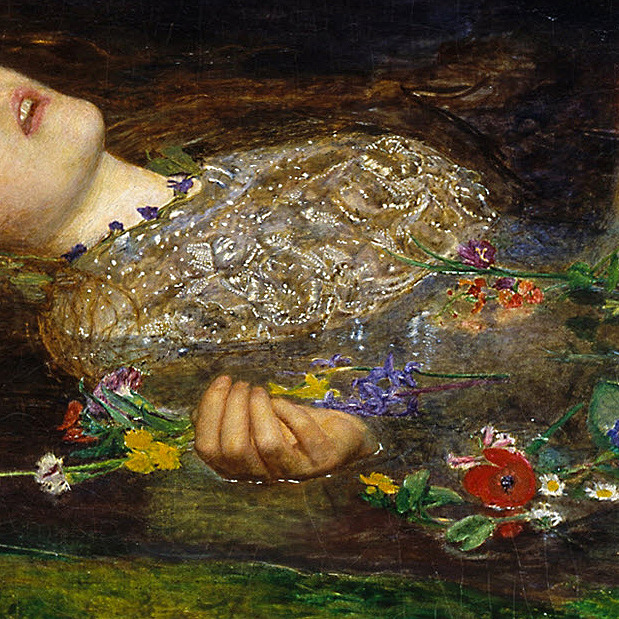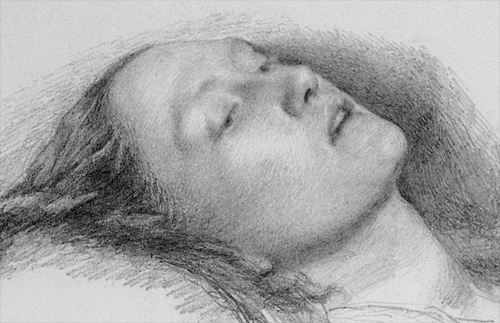Ophelia is a painting by British artist Sir John Everett Millais, completed between 1851 and 1852. Currently held in the Tate Britain in London, it depicts Ophelia, a character from Shakespeare's play Hamlet, singing before she drowns in a river in Denmark.
Ophelia's pose—her open arms and upwards gaze— resembles traditional portrayals of saints or martyrs, but has also been interpreted as erotic.
In the 20th century, the painting was championed by surrealist painter Salvador Dalí. In an article published in a 1936 journal, he wrote, "How could Salvador Dalí fail to be dazzled by the flagrant surrealism of English Pre-Raphaelitism. The Pre-Raphaelite painters bring us radiant women who are, at the same time, the most desirable and most frightening that exist."
http://en.wikipedia.org/wiki/Ophelia_(painting)
I first saw John Everett Millais's Ophelia when I came to the UK in 1961 and was struck by its originality. I guess I had a fondness for all sorts of pre-Raphaelite images back then. The feeling passed, but the nature of this painting stayed with me.
At
first, I didn't delve into its story and symbolism. I viewed it
strictly as a picture, how it was composed and so on. But later I
learned that it had been analysed by so many people. Every blade of
grass and each plant has been botanically identified, and someone has
found almost exactly where Millais set up his easel. Some believe there is a skull hidden just to the left of the forget-me-nots on the right.
The
painting became a trigger in my art, an inspiration. You look down on
her from an oblique angle, so the painting is an aerial view; the
diagonal of her body in the water is an aspect my work
echoes.
My study of art is ordered on that thinking: that you look at
something almost as if it were a tabletop arrangement. I regard a lot of
my paintings and even my photographs as the offspring of this painting.
Ophelia
is in the grand tradition of English painting, and its story goes back
to Shakespeare; my work goes back to 1968 and, you could say, is the
culmination of commercial America. But pictorially they are connected,
like brother and sister. Each time I come to London, I feel obliged see
it. In some ways, I feel I am looking at myself.
Ed Ruscha
http://www.guardian.co.uk/artanddesign/2012/oct/10/frieze-2012-big-art-inspiration
Lizzie Siddal, known for her luxuriant red hair and pale skin, was the model for Millais’s immensely popular, Ophelia. Here,
her necrophiliac beauty has something of the demure countenance of a
Raphael Madonna. While posing she lay in a bathtub full of water.
Millais painted her daily into the winter, filling in the blank space he
had left on the canvas after already painting the surrounding landscape.
Although he put lamps under the tub to warm the water they went out and
the water slowly chilled. Millais didn’t seem to notice and Lizzie
didn’t complain. Afterwards she became very ill, possibly with
pneumonia, and her father held Millais responsible, forcing him to pay
compensation for her doctor's bills.
Sue Hubbard
http://www.3quarksdaily.com/3quarksdaily/2012/11/pre-raphaelites-victorian-avant-garde-tate-britian-till-13th-jan-2013.html
This picture really does shock me. And I have only just realised quite why I am so fascinated by it.
It
is because Ophelia looks as if she is already dead. That face is
transfigured, the eyes are sightless; it looks like that of a corpse -
in fact, like the kind of dead female body recovered from a watery grave
that forensic thrillers take such sinister prurient delight in showing
us. This is a CSI Ophelia, a Patricia Cornwell Ophelia: both assailant
and victim. I can imagine yellow crime-scene tape all around that
stretch of water. There is a horribly brilliant, necrophiliac edge to
the painting: Millais has seen female vulnerability in its ultimate
form, and the image is grippingly voyeuristic.
Peter Bradshaw
http://www.guardian.co.uk/film/filmblog/2007/sep/25/millaisthegreatestcinematographerofthenineteenthcentury
Some people believe there is a skull hidden within the painting.
Before the location is revealed, have a look and see if you can see it (once it is pointed out, it is hard not to see it).
Look to the left of the forget-me-nots on the right of the painting, a nose and two hollow eyes can just be made out.
This may well be just the light and shade in the foliage or the skull may be a reminder of death and hint at what is about
to happen.
Rebecca Virag
http://www2.tate.org.uk/ophelia/subject_symbolism.htm
Ben Robinson - Death Paints Red Daubings 2012, photo by Ross Fraser McLean
Thursday 3 January 2013
Subscribe to:
Post Comments (Atom)




.jpg)


No comments:
Post a Comment